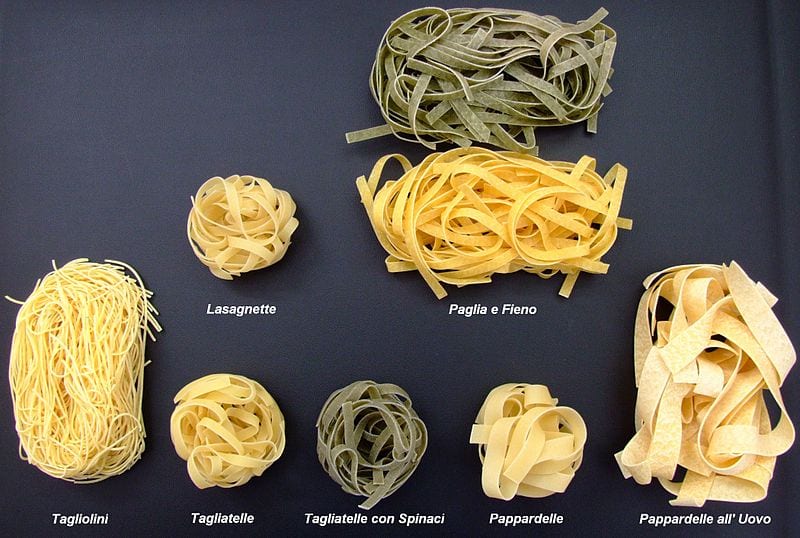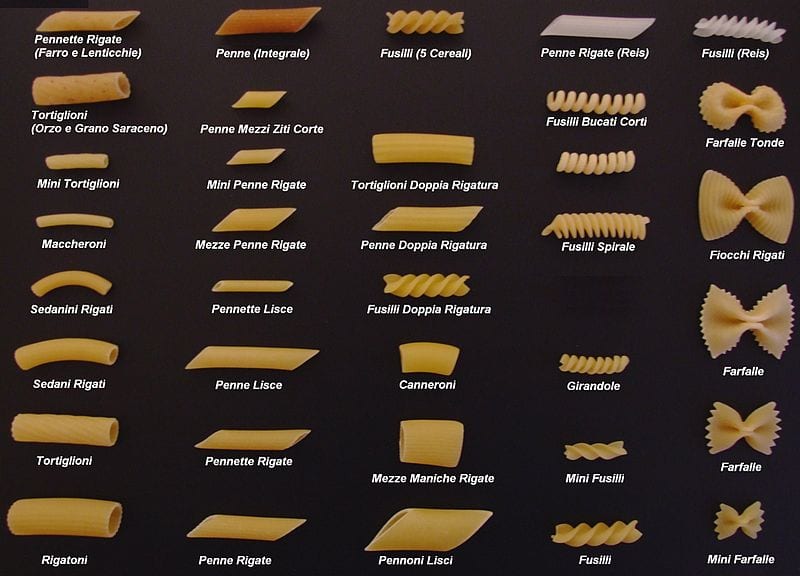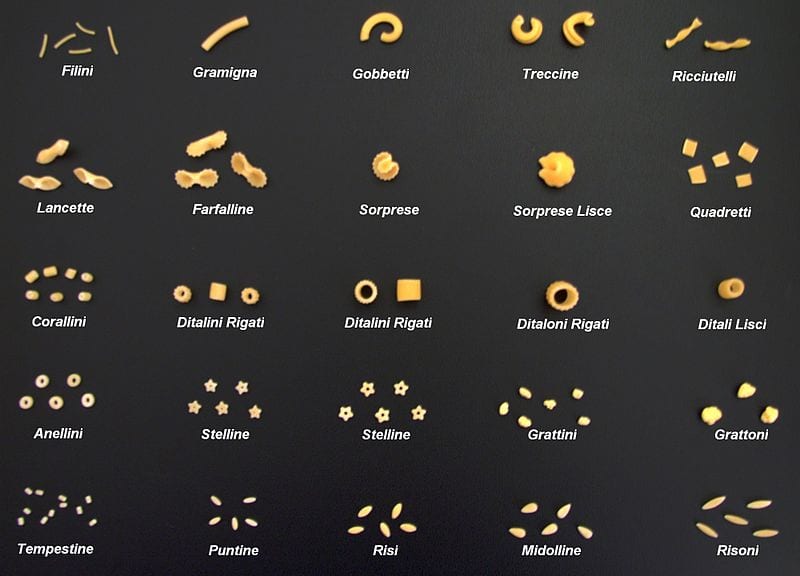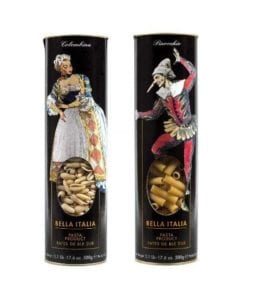
Today over 300 types of pasta consumed in Italy and they can be classified as dry and fresh pasta (full or holed), short, fine, smooth, striped. The innumerable type of pasta can be distinguished by dough, shape, surface and the possible presence of the filling. A variety that testifies, once again, to the immense wealth of the Italian culinary heritage, able to combine history and innovation, tradition and creativity of one of the most loved and appreciated products in the world. The type of pasta is not only the fruit of imagination, the different formats are a matter of taste and the choice is also linked to the consistency and to the dressing with which it will have to be married.
Pasta is the queen of Italian culinary tradition. It is loved by adults and children and the different types of pasta are seasoned with sauces of all kinds: vegetables, meat, or fish.
There are countless formats in Italy: some type of pasta are known all over the world while others are popular in the only source area.
Long, short, or minced pasta is for all tastes: just choose what to cook and with which sauce accompany it!
Below is a list of the best-known pasta sizes in Italy.
History of Pasta
The history of pasta has its origins in ancient times, well before the Chinese spaghetti that Marco Polo, who returned from the East in 1295, had the opportunity to know. Etruscans and Romans, according to archaeological findings, already prepared and ate the lagana, the ancestor of modern lasagna, made up of sheets of pasta stuffed with meat cooked in the oven. In an Etruscan tomb in Cerveteri were found a pastry board, rolling pin, knife, a bag for dusting the flour and even a wheel which presumably was used to make the wavy edges. But the history of dry pasta as we know it today is linked to the Arab domination of Sicily according to various historians. It was 1154, when the Arab geographer Edrisi mentioned “a food of flour in the form of threads”, the “triyah” prepared in Trabia (present-day Palermo). From Sicily the pasta so prepared was then exported to the continent. Also according to the Arab geographer, already in the mid-1100s in Sicily and in particular in the Trabia area, so much “pasta” was produced that it was exported “in all parts, in Calabria and in other Muslim and Christian countries “. In the Arab cookbooks of the 9th century there were already paragraphs of pasta, with manufactures typical of the blackberry culture for its production: dry pasta was suitable to be preserved for a long time even crossing long journeys in the desert. Over the years, dry pasta has become a productive “prerogative” of the regions of Southern Italy and Liguria: the dry and windy climate of these lands is ideal for drying in the open air.
Bronze Drawing
Bronze drawing is the process by which the mixture of semolina and water used to make dry pasta is passed by extrusion / compression through a bronze die. The drawing therefore gives shape to the pasta but also determines its length thanks to rotating knives that cut the forged dough that comes out of the matrix according to the desired length. The bronze drawing allows the surface of the finished product to be porous and rough, which means a greater ability to “catch” and retain various types of condiments, starting with generous sauces and succulent sauces. The bronze drawn pasta is also opaque and wrinkled, with the surface covered with starch powder, for a perfect marriage, for example, with a nice fresh tomato sauce. Among the other advantages related to bronze drawing it must be said that the subsequent drying of the pasta at very low temperatures, which also means a greater “hold” of the pasta’s nutrients and organoleptic qualities of the raw material grain.
Low-temperature Drying
This slow and low-temperature drying technique allowed, then as today, to preserve all the nutritional values of the ingredients: the total maintenance of proteins, antioxidants, fibers and amino acids present in the raw materials, proved to be fundamental for a healthy diet. as for the digestibility of the pasta itself. Slow drying at low temperatures does not alter the structure of gluten, avoids the dispersion of important nutrients and the formation of undesirable elements such as furosine. The drying of the pasta follows a slow process that reaches up to 18 hours for some formats to respect the integrity of the raw material. Slow drying at low temperatures does not alter the structure of gluten, avoids the dispersion of important nutrients and the formation of undesirable elements such as furosine.
Durum Wheat Pasta
To be named as such, durum wheat semolina pasta must be the result of drawing, rolling and drying a dough prepared exclusively with durum wheat semolina and water, without the addition of coloring and preservatives. The particular properties of durum wheat ensure that the starch does not disperse and therefore the pasta does not overcook, ensuring that it is cooked with a unique and authentic taste. Durum wheat is a type of wheat that breaks easily, has a coarse grain and an amber-yellow color. From its grinding we obtain semolina, whole semolina and re-milled semolina. Compared to white flour, semolina is more grainy and of a more intense yellow, due to the presence of carotenoids. Durum wheat semolina has a high tenacity and less extensibility than white flour and is therefore suitable for both bread making and pasta production.
Egg Pasta
Egg pasta is a basic preparation of Italian cuisine, in particular of the Emilia area. It is a simple dough, made with chicken eggs and wheat flour, divided into small regular shapes and intended for cooking with moist heat. The origin of pasta certainly dates back to the prehistory, when our ancestors ate grains that were crushed, ground, macerated and cooked in water. The Arabs and the Etruscans knew how to prepare lasagna, tagliatelle, fettuccine , pappardelle, macaroni, gnocchi, as we understand them today. The more ancient is the origin of ravioli. What do all these pastas have in common? They are egg pasta, that is, produced using eggs in addition to flour and water. Therefore, egg pasta, to be considered as such, must be produced using whole chicken eggs, without the shell, and specifically with fresh eggs: 4, equivalent to 200 grams of eggs, for each kilogram of semolina (for dry pasta), or flour (for fresh ones). Its production takes place both at an artisanal and industrial level. Egg pasta is produced in numerous formats; noodles are certainly the best known and most widespread.
Long Pasta:

- Spaghetti are the best-known dry pasta, originating in Campania, southern Italy;
- Pici, typical of Tuscany, are larger spaghetti larger by hand;
- Bigoli form Veneto is a different version of spaghetti, they are more homemade and often are made with wholemeal flour;
- Guitar Spaghetti (also called Chitarrine or Tonnarelli) come from Abruzzo ant they are characterized by the same recipe of classic spaghetti, but with a square section instead of round;
- Tagliatelle from Emilia Romagna is the best-known egg pasta;
- Fettuccine is the sister of Tagliatelle but are taller (at least 1cm thick);
- Lasagna: always originating in Emilia Romagna are lasagna, much larger pasta strips perfect for being seasoned with sauerkraut and mozzarella for the classic Italian lasagna;
- Tagliolini are like spaghetti, but they are flat rather than flat;
- Pappardelle, they are like spaghetti but with a wider diameter;
- Pizzoccheri born in Lombardy, particularly in Valtellina, and are a type of buckwheat pasta:
- Bucatini is typical of Lazio and is cable spaghetti internally.
- Spaghetti is a particular type of pasta produced exclusively with durum wheat semolina and water, with a long and thin shape and a round section. They are distinguished from other similar formats, such as vermicelli, since, compared to the latter, they are drawn with a smaller section (caliber). In the same way, bucatini, which are hollow, therefore perforated in the center and along their entire extension and linguine, must be distinguished from other similar types of long pasta such as spaghetti alla chitarra, since they have a square section and not processed by drawing , of flattened shape. Although each pasta factory uses its own caliber, generally, spaghetti is the reference meter for long round-sectioned pasta with a caliber lower or higher than it. Despite the obvious variations depending on the manufacturer, the size generally increases in this order: strands of angel or capellini (also called angel hair), noodles, spaghetti, noodles, vermicelli and vermicelloni.
Tagliatelle
Tagliatelle is an egg pasta typical of Emilia and widespread in the traditional cuisine of Central and Northern Italy. Its name derives from the verb “to cut”, since traditionally they are obtained by rolling the dough into a thin sheet and cutting it, after having rolled it. The origins of tagliatelle are very ancient and difficult to document, as their history is intertwined with that of other pasta shapes, widespread since Roman times such as the lagane mentioned by Orazio. In Emilia, and especially in Bologna, the classic recipe wants the tagliatelle to be seasoned with Bolognese ragù, prepared with beef pulp, ground and cooked in a sautéed butter, bacon, herbs, cooked with broth, wine and tomato paste, and generously covered with Parmigiano Reggiano.
Linguine
Linguine is a type of long durum wheat semolina pasta. They belong to the same family of bavette and trenette (in Genoese “trena” means “strings”) originating from Genoa. Unlike spaghetti which have a round section, linguine has a rectangular section. They are flat “spaghetti”! There is a first trace of this pasta shape starting from 1700. Giulio Giacchero tells us about a format similar to linguine, trenette, seasoned with pesto, green beans and potatoes (“Economic history of the 18th century Genoese”). It was the typical festive dish of the Ligurian families of the time.
Pappardelle
The pappardelle is a type of egg pasta similar to tagliatelle but with a much greater width, about 13 mm. It is a very popular format in Sicily that originates in Tuscany. This larger version of tagliatelle was eaten in eastern Tuscany as early as the late Middle Ages, it is mentioned later in writings from the 13th century. Boccaccio names them in the Decameron (VIII, 3) speaking of the village of Bengodi where they cooked them in capon broth. The name then established itself on similar pasta shapes throughout the center-north, with the spread of the Tuscan vulgar as can be seen from many treatises from the middle of the past millennium. In the 16th century the high-ranking cook Domenico Romoli, described them as thin, delicate and soft lasagna and included the Florentine pappardelle soup in the menus reserved for the cardinalate Rome of that era. Already in the nineteenth-century Italian Dictionary of Niccoló Tommaseo, “pappardelle” was recognized as a term of the Italian language.
Lasagna
Lasagna is the name of one of the oldest forms of pasta, usually rectangular or ribbon, and a little thicker than a tagliatella. The Italian lasagna seems to be linked to the Greek “lasanon”, in Latin “lasanum”, which indicated the tripod to be taken over the fire or even the container that was used for cooking food. It was then referred to as “laganon” and “laganum” a thin sheet made from a dough made from wheat flour, which was baked in the oven or directly on the fire. In the Apicius recipe book these sheets of pasta are used to cover pies, but also to prepare a dish cooked in the oven called “lagana”, in which the sheets were topped with meat filling. Only later in the sixth and seventh centuries we have evidence of the cooking of this food in moist heat, ie in wat
Short pasta:

- Penne comes from Campania and are transversally cut tubes; they are half-pens if they have a smaller size and can be smooth or striped;
- Tubular Macaroni pasta;
- Fusilli typical of the Campania pasta very well known thanks to its spiral shape;
- Paccheri originating in Campania are tubular shaped with a wide diameter compared to the above-listed types, they look like squares;
- Rigatoni, similar to macaroni but slightly larger and originally from Campania;
- Trenne are similar to Penne but of a triangular shape;
- Cavatelli from Puglia are irregular tubular form;
- Shells or “Conchiglie” are shaped like shell valves and if they are large they are called Conchiglioni;
- Butterflies or “Farfalle” are named after their similarity with the common insect and are native to Liguria; they can also be called Farfalline or Farfallone depending on the size;
- Maltagliati: in Emilia Romagna there are the Maltagliati characterized by an irregular shape and often different from one another;
- Orecchiette of circular shape come from Apulia, often made by hand and served with a sauce made of rapeseed;
- Passatelli usually served in broth and they are typical of Emilia Romagna;
- Corzetti: Ligurian rinds are a rustic tip of losanga-shaped pasta;
- Trophies also come from Liguria and are characterized by an elongated shape, thin and rolled on itself.
Minced Pasta (usually used for soups):

- Stars and Butterflies loved by the little ones;
- Pastina small spheres large as peppercorns;
- Ditalini are small tubes originating in Campania;
- Fregola is typical of Sardinia of circular shape, mainly used with fish-based sauces.
IGP and DOP Pasta
Cappellacci di Zucca Ferraresi
At first glance, they recall the warm and bright colors of autumn and, tasting them, release a complexity of flavors and aromas that will console you during the grayest days and rainy
Its history begins around 1570 with the spread and cultivation of this orange vegetable in the Ferrara countryside. From the sixteenth century to today, this excellent preparation has acquired an enormous reputation thanks to the originality of its shape and simple and complex flavors at the same time. In fact, to emphasize precisely the exceptional nature of the product, in 2016 comes the recognition of the Protected Geographical Indication and, with it, also a strict protection policy. According to the document, the cappellacci consist of a fresh filled pasta, the pastry of which is obtained thanks to a mixture of eggs and soft and hard wheat flour, and whose filling is formed by a mixture of yellow pumpkin pulp, grated cheese and nutmeg. And at the time of placing on the market, the product must have specific characteristics in order to be named IGP.
Culurgionis d’Ogliastra
Culurgionis d’Ogliastra PGI is a fresh pasta with a hand-closed bundle shape and a filling consisting of a mixture of fresh or dehydrated potatoes in flakes, cheeses, vegetable and / or animal fats, flavorings. The production area of Culurgionis d’Ogliastra PGI includes numerous municipalities in the province of Nuoro and three municipalities in the province of Southern Sardinia, in the Sardinia region. Culurgionis d’Ogliastra PGI have carved out a place for themselves as protagonists thanks to the identification with the geographical area of production, Ogliastra, particularly immune to cultural contamination from other regions. They are born as a poor dish, typical of the agro-pastoral culture, for which the filling has been adapted to the availability of local products. Potatoes were among the products almost everyone had. To enrich the taste they were flavored with cheeses, fats and aromas.
Maccheroncini di Campofilone
Maccheroncini di Campofilone IGP is a dry pasta obtained from the processing of eggs and soft wheat flour or durum wheat semolina. The production area of Maccheroncini di Campofilone PGI covers the territory of the municipality of Campofilone in the province of Fermo, in the Marche region. The artisanal production of Maccheroncini di Campofilone PGI is the manifestation of the popular tradition of the medieval village of the same name, handed down from generation to generation. Maccheroncini di Campofilone PGI are distinguished from other pasta dishes for the thinness of the sheet and the very fine cut.
Pizzoccheri della Valtellina
Pizzoccheri della Valtellina PGI is a pasta made from a mixture of at least 20% buckwheat flour mixed with flours of other cereals. The first document to attest to the use of buckwheat in Valtellina dates back to 1616. The production area of Pizzoccheri della Valtellina PGI includes the entire territory of the province of Sondrio, in the Lombardy region. Pizzoccheri della Valtellina PGI attributed not only an economic value, but also a cultural one, to the point of becoming a real popular reference tied to tradition and celebrated in numerous festivals, including the most famous is the “Pizzocchero d’Oro” of Teglio.
Pasta di Gragnano
Pasta di Gragnano PGI is a pasta obtained by mixing durum wheat semolina with water from the local aquifer. The formats released for consumption are different and all typical, with its characteristic rough surface given by the bronze drawing, fruit of the imagination of Gragnano pasta makers. The production area of Pasta di Gragnano PGI includes the whole territory of the municipality of Gragnano, in the province of Naples, in the Campania region. Thanks to its consolidated tradition, the city is today referred to as the city of pasta. The historical importance of pasta production in Gragnano has been such as to influence the design of urban spaces over the centuries. The manufacturing process of this pasta is the result of centuries of experience and tradition. The particular care with which each phase is followed and carried out contributes to the full success of the entire production process and, together with the originality of the shapes resulting from the imagination of local master pasta makers, helps to give the product international fame and reputation.




